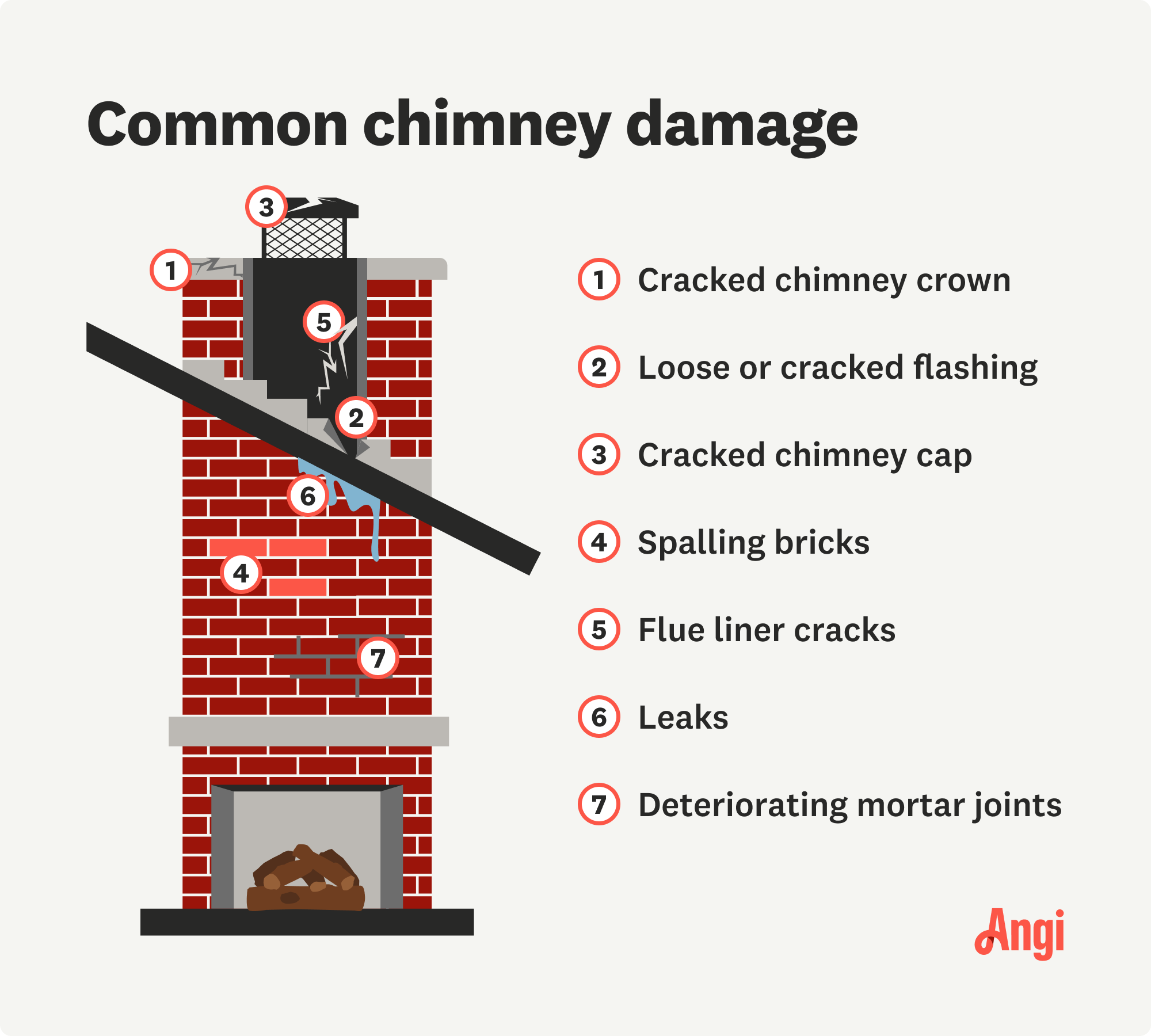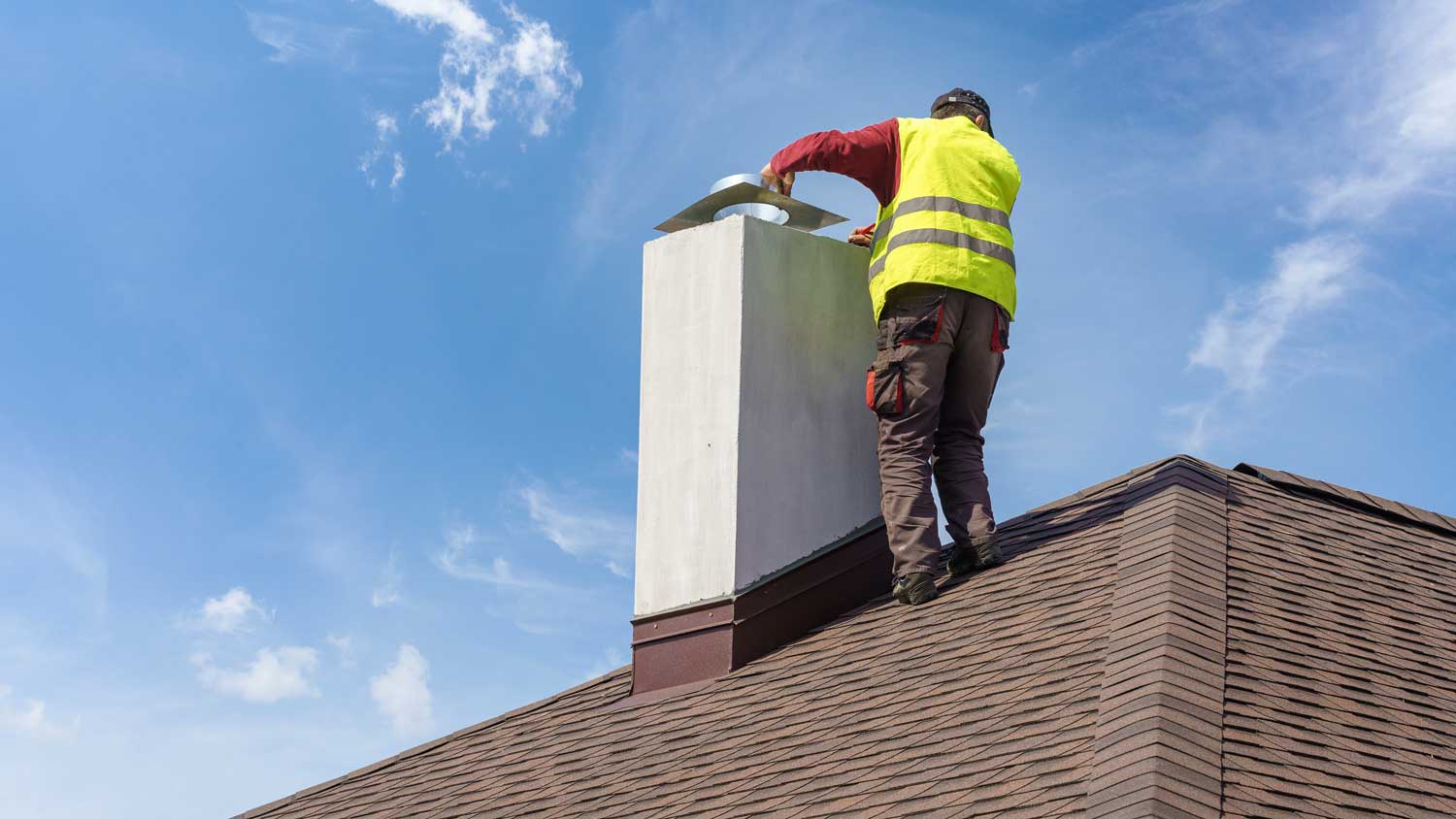
Notice leaks and corrosion around your chimney? You might need new flashing or some careful repairs. Here are some common chimney flashing repair costs.
A chimney inspection costs $450 on average, depending on the type of inspection. Most homeowners spend between $100 and $5,000.


On average, a Level 1 inspection starts at $100, a Level 2 inspection starts at $200, and a Level 3 inspection starts at $500.
You cannot DIY a chimney inspection because people who inspect chimneys must have national certification.
It costs more to inspect taller chimneys, those on a steep roof, or chimneys that require a pro to use a remote video camera.
Nothing creates a coziness in your home quite like a roaring fire—and maybe a cup of cocoa —on a winter night. To be able to run your fireplace safely and securely, though, you need to be willing to include the cost of a chimney inspection in your annual household budget. So, how much does a chimney inspection cost? Depending on the complexity of the work required, expect to pay between $100 and $5,000, but the average chimney inspection costs about $450. The good news is that most chimney inspectors are also licensed as chimney sweeps and will clean the chimney at the same time.
| Level 1 | Level 2 | Level 3 |
|---|---|---|
| Least expensive | Slightly costlier than Level 1 | Extremely high cost |
| For operational chimneys | For chimneys after minor repairs | For chimneys that have been idle |
| For no known problems with chimney | For chimneys with new fuel sources | For chimneys with likely structural damage |
| Verifies basic structure is intact | May use video camera for inspection | May inspect chimney in concealed areas |
| Inspects only easily accessible areas | May go inside crawlspace or attic | May need to remove parts of chimney structure |
Local chimney inspectors will perform one of three levels of inspection, depending on the condition of the chimney.
The level of inspection is the primary factor in determining how much a chimney inspection costs. A Level 3 inspection requires far more work and time than a Level 1 inspection, resulting in a higher cost.
Fortunately, most of the time, the inspector will only need to perform a Level 1 inspection.
So what is a chimney inspection at Level 1? This is the most common inspection, as it involves visually inspecting the chimney’s exterior for any damage. The inspector also cleans the chimney’s interior and then inspects it for any damage.
A Level 1 inspection costs between $100 and $950. If you have more than one flue or if you have an especially tall chimney, you could pay at the higher end of the range. Short chimneys with only one flue may carry a cost at the lower end of the range.
Inspectors recommend a Level 1 inspection when they know the chimney works and when it hasn’t sat idle for more than a year.
If you need a chimney inspection as part of the process of selling a home, a Level 1 inspection is common.
A Level 2 inspection may occur when the inspector knows the chimney has been idle for more than a year or if a repair to the chimney recently occurred. If you are switching from a wood fireplace to gas or vice versa, you also may need a Level 2 inspection.
Expect to pay in a range of $200 to $1,000 for a Level 2 inspection. As with Level 1, if you have multiple flues or a taller-than-average chimney, you’ll pay closer to the top end of the range.
In addition to performing the visual inspection found in Level 1, inspectors may climb into crawl spaces and attics to inspect the chimney more closely during Level 2. They may also use remote video cameras to look at areas of the chimney that are not easily accessible.
The Level 3 chimney inspection is the most thorough process. This occurs with a chimney that has been idle for multiple years or that has extensive damage.
You could pay anywhere from $500 to $5,000 for a Level 3 inspection. The high cost occurs because inspectors must do a close inspection of the entire chimney structure, including the interior of the flue.
Inspectors may need to put holes in walls or may need to remove portions of the chimney structure to inspect certain areas. If so, you’ll pay a price near the top of the cost range because repairs will be necessary.
Inspectors rarely do a Level 3 inspection, unless there is clear evidence that it is necessary. Such evidence could include crumbling brick, damage in the chimney from wildlife, a report of carbon monoxide leaking from the flue or fireplace into the home, or a report of a fire inside the chimney from creosote buildup.

Some of the factors that may drive up the cost of a chimney inspection include:
Accessibility: When accessing the chimney structure for inspection is difficult because of tight quarters or because of overhanging trees, the cost of a chimney inspection will climb.
Environment: If the inspector must work on an extremely steep roof or a shaky roof structure, you can expect to pay more.
Flues: If you have more than one flue, expect to pay a higher cost for inspections.
Size: Taller and larger chimneys have a higher-than-average inspection cost versus smaller chimneys.
Video: If the inspector must deploy a remote video camera to see certain portions of the chimney, you’ll pay an extra price.
It’s important to note that if your chimney needs repairs because of what the inspector found, these costs would be separate from any inspection costs. If you hire a local chimney repair specialist, expect simple repairs to cost between $160 and $750 and more complex repairs up to $15,000.
Houses over 40-50 years old need to be looked at periodically to make sure they're in working order. Look for shifting in the tiles, gaps in holes in the flue lining where gases can escape, and creosote buildup, which can start chimney fires.
Even though you could save on the chimney inspection by doing the work yourself, we don’t recommend it. For starters, you will need to know what creosote buildup looks like on the interior of a chimney. Creosote clings to the interior of the chimney as you use the fireplace. Because creosote is highly flammable, you need to be able to spot it during the inspection, so you can clean the chimney and prevent dangerous fires.
You also must be able to understand how seemingly minor chimney damage could lead to significant performance issues or leaked gases that put your family in danger.
Inspecting the chimney requires climbing on and working on your roof for multiple hours. You also may need to crawl into tight spaces to reach areas of the chimney that need inspection.
Because the inspector often cleans the chimney as part of the inspection, you also would need quite a bit of gear to do the cleaning. You may find that the cost of buying this gear exceeds the cost of hiring an inspector.
Official chimney sweeps and inspectors need national certification, which gives them training in spotting key issues inside the chimney. Homeowners simply don’t have this training available to them without seeking their own certification.
Some homeowner insurance companies require an annual inspection of a chimney from a certified pro when you are using the fireplace regularly, rather than allowing you to inspect the chimney yourself.
Because a chimney with structural damage or with a significant buildup of soot and creosote could lead to a fire or could cause dangerous gases to leak into your home, hiring a pro is the best and safest option for nearly everyone.
It’s just not worth the risk of making a mistake with a DIY job.

When you hire a local chimney inspector, the cost is typically fixed. However, there are a few ways you can reduce the overall cost of the inspections over several years.
Start by scheduling an annual chimney cleaning and inspection together. When you keep the chimney clean regularly, you can avoid significant problems that require an expensive, specialized cleaning process. Additionally, annual inspections can catch problems while they are minor, meaning it costs less to fix them.
Before the inspector comes, check the fireplace for any leftover ash and remove it. If you don’t mind climbing on the roof, do a quick inspection of the area around the chimney before the inspector arrives. Remove bird nests or trim back trees around the top of the chimney to make it easier for the inspector to work, which may bring the inspection cost down slightly.
From average costs to expert advice, get all the answers you need to get your job done.

Notice leaks and corrosion around your chimney? You might need new flashing or some careful repairs. Here are some common chimney flashing repair costs.

Replacing your chimney increases home value and prevents hazardous structural damage. Learn how much to budget for chimney replacement costs.

If you’re experiencing chimney airflow problems, a new damper may be in order. Use this guide to learn what goes into your chimney damper replacement cost.

Oversized flues lead to chimney corrosion, freeze/thaw damage, and an uncomfortable draft. Here are the standard chimney flue sizes to ensure proper integration.

What is repointing a chimney? Repointing a chimney is a necessary repair to keep your structure leak-free. Find out what’s needed and how long it lasts.

Cracks in your chimney crown will grow over time and cause serious structural problems. Learn how to repair a chimney crown and prolong your chimney’s lifespan.